How CPCs Differ Across Online Ad Networks
There’s no shortage of buzz around digital advertising nowadays. It seems like every business big or small is looking for ways to grow their business online. With the proven ROI that online advertising provides, this is no surprise.
Before getting started, it’s important to know how far your money can go and what you can expect to achieve in terms of traffic and return on investment. One of the most important metrics to keep track of is CPC or cost per click.
This metric tells you how much you’re paying per click on your ads. Clicks on ads are important because they generally take someone from the platform they’re seeing your ad on (Google, Facebook, etc.) straight to your website. CPC is calculated by taking the amount spent on advertising and dividing it by the number of clicks in a given time period.
So how do you know what to expect in terms of CPC when you don’t have any data? Don’t worry, we did the research for you! We found the average CPCs across some of the top online ad networks to see how they differed and what types of businesses they serve the best.
Let’s start with the highest converting, largest online ad platform of them all, Google Ads.
Google Ads
To this day, Google Ads is still one of the highest converting advertising mediums out there. From its inception back in 2000, the platform has gone through hundreds of updates, multiple rebrands, and has added various features for advertisers.
Most notably, Google added other “networks” as options for advertisers to reach people outside of traditional text ads on the search network. These are the Display, Shopping, and Video networks.
Not only has the platform itself changed, but the costs for advertisers has changed as well. With more advertisers bidding on keywords than ever before, this has naturally raised prices across the board. Since the platform charges advertisers on a per click basis, these prices are reflected in the CPC or cost-per-click.
Before choosing the Google Ads network to promote your business, it’s important to understand the average CPC you’ll be paying. This way, you’ll know the results you can expect to achieve with your budget.
To help get you started, we outlined average CPCs and what they mean across all the Google Networks below!
Google Search Ads
The average CPC across all industries for Google Search ads is $2.69. This of course varies dramatically between industries as CPCs can be as high as $6.75 for the law industry and as low as $1.16 for E-Commerce.
Search is by far the most tried and true Google Ads network. It allows us as advertisers to target specific high intent keywords so your business shows up the moment someone is looking to buy.
For most industries (outside of E-Commerce), if you’re looking for a real return on your investment, Google Search ads are the best place to start.
For reference, this is what a Google Search ad looks like

Google Display Ads
The average CPC across all industries for Google Display ads is $0.63. Again, this will vary between industries. For example, average Display CPCs are $1.49 for the Dating industry and $0.44 for the travel industry.
Google Display ads are great for any business that has great creative assets they want to leverage for brand awareness. Generally, Display ads lead to less conversions but are cheap clicks that can constantly put your brand in front of consumers, eventually leading them to convert.
As you can see with the CPCs above, Display ads can work very well for visual industries that generate their income by influencing impulse decision making on the part of the user.
For reference this is what a Google Display ad looks like
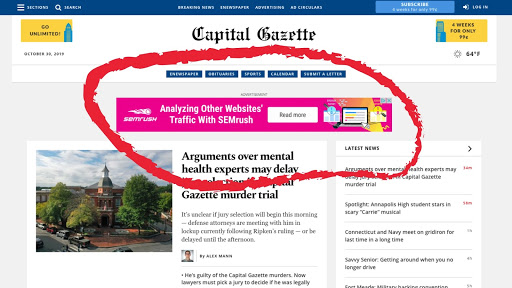
Google Shopping Ads
The average CPC for Google Shopping ads is $0.66. Google Shopping ads are specific only to the E-Commerce industry where people searching for a product can quickly and easily see their options at the top of the SERP (search engine results page) without having to scour through multiple websites.
The Shopping network is the best of both worlds for stores on the web. Similar to Search, its main goal is to drive conversions (purchases) and the clicks are just as cheap as Display. There’s also some added benefit of differentiation and brand awareness with the imagery included on Google Shopping ads.
For reference, this is what a Google Shopping ad looks like
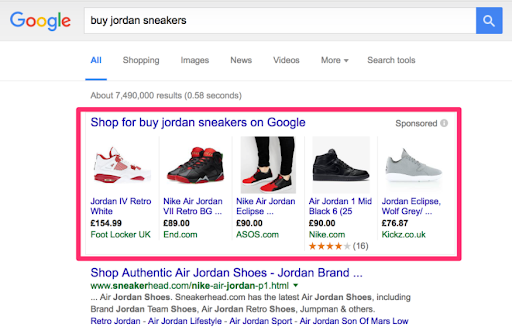
Google Video Ads (YouTube Advertising)
The average CPC across all industries for Google video ads or “YouTube ads” is $3.61. Again CPCs across industries will differ.
YouTube ads are a great way for businesses to sell their products and services online. It works similar to Google Search ads where advertisers can target specific keywords or audiences to show up for.
Due to the nature of YouTube as an informational and learning platform, the searchers may not be ready to buy, but simply looking for information. When done well, YouTube ads can inform and convert users who are interested.
That’s why YouTube ads work so well for industries that require some explanation to grasp, like E-Learning and SaaS.
For reference, this is what a YouTube ad looks like
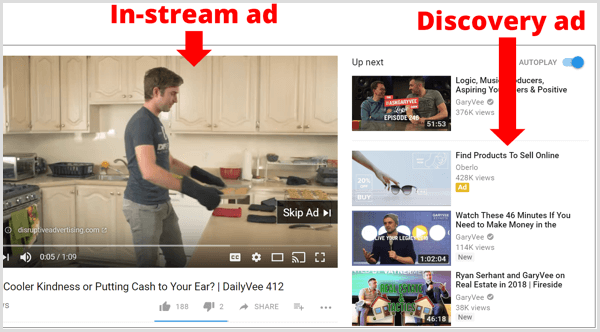
Facebook Ads
The average CPC for Facebook ads across all industries is $1.72. They can be as low as $0.45 for the apparel industry and as high as $3.77 for the finance and insurance industries.
Facebook ads are at the top of the online advertising hierarchy. There are so many different objectives, ad types, and targeting methods, that practically any business/industry can see success from advertising on Facebook.
If you have an info or SaaS product, you can choose video ads to explain what your product does to users. If you run an ecommerce store with a large catalogue, you can take advantage of dynamic ads that combine your top assets to show users products they want to see. If you have a service business, you can take advantage of Facebook lead forms that allow you to ask users some questions and get their contact information.
With all these options, it’s easy to see why Facebook is still one of the largest advertising platforms in the world.
For reference, this is what a Facebook ad looks like
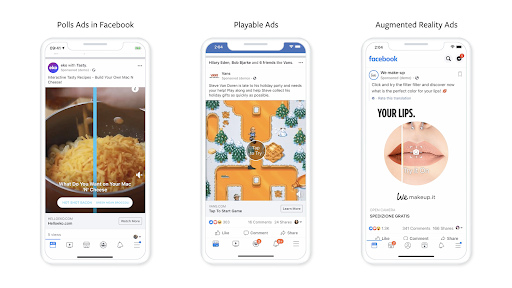
Instagram Ads
The average CPC for Instagram is $0.94. This is by month, where in February it can go as low as $0.60 and in October can go as high as $1.42.
Instagram is owned by Facebook and as such, is run on the Facebook ads platform. Although they run on the same platform, the audiences and advertising formats found on Instagram differ greatly from Facebook.
Because of its demographics and the nature of the platform, aesthetic industries that speak to younger audiences tend to do very well on Instagram. These industries include but are not limited to beauty, fitness, food, travel, pets, entertainment, etc.
For example, you would likely not see much success advertising a plumbing service on Instagram versus Facebook. On the other hand, if you advertised fitness apparel on Instagram, it would likely produce better results than Facebook.
For reference, this is what an Instagram ad looks like:
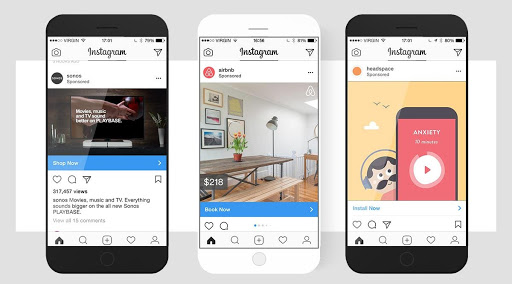
LinkedIn Ads
The average CPC for Linkedin Ads is $5.26. LinkedIn ads have higher costs across most key metrics than any social advertising platforms.
LinkedIn advertising is a great tool for B2B businesses to get in front of key decision makers in certain companies/industries. LinkedIn allows advertisers to target members based on job titles, job seniorities, job functions, industries, companies, company size, degrees, and much more.
The high costs are justified especially when going after such specific audiences. A good rule of thumb is, the smaller/more specific the audience, the higher the costs.
Another factor that affects the price of Linkedin ads is the value of the conversions. On LinkedIn, a B2B conversion is valued higher than a conversion on any other social platform. For example, a conversion (purchase) for a beauty store on Instagram could be worth around $60, whereas a conversion for an IT company on LinkedIn could be worth thousands of dollars per month over multiple years.
For reference, this is what a LinkedIn ad looks like:
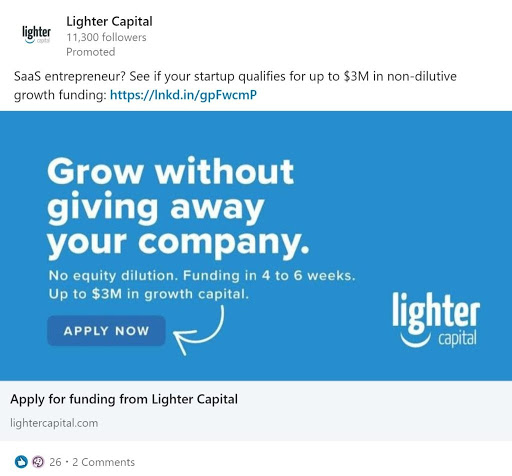
Twitter Ads
The average CPC for Twitter ads is $0.40. This can vary though as some say it can be as high as $1.20 and others say it hovers around $0.53. These differences in CPC could be due to times of the year, audiences, industries, and more.
Twitter ads are unique in that they charge advertisers only if their objective is met. For example, if your advertising objective is to get engagement on a post, Twitter only charges you per engagement, not impressions or clicks. Or if your objective is to get mobile clicks, they’ll charge you per mobile click, not engagements or impressions.
This is good news for advertisers that have a limited budget and want to do the most with their money. You’re basically guaranteed to hit your target objectives (as long as they’re supported on the platform) through Twitter advertising.
The look and feel of Twitter ads are similar to Instagram and Facebook. The differences lie in their targeting techniques. Twitter allows you to target ads through the standard demographic, device, and location targeting options. In addition, you can target based on interests, behaviors, keywords, hashtags, followers of certain accounts, and more. You can even upload your own list to target.
For reference, this is what a Twitter ad looks like:
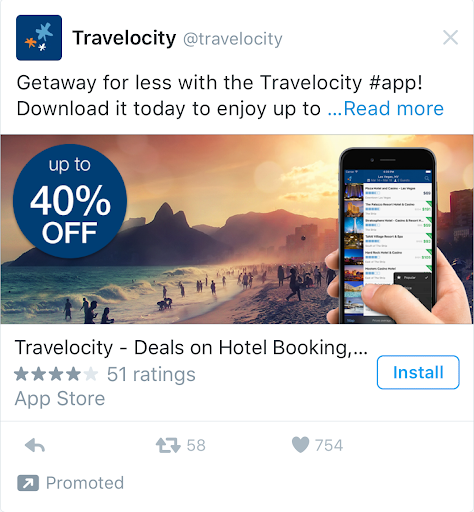
Microsoft (Bing) Ads
The average CPC for Microsoft (Bing) ads is $1.54 across all industries. These costs can go as low as $0.75 for the job industry and as high as $2.88 for the real estate industry.
Bing is a search engine so its ads show up when someone searches for a specific keyword. Advertisers bid to show up for that keyword when someone searches it.
Microsoft’s advertising structure is extremely similar to if not exactly like Google’s. Just like Google, Microsoft (Bing) has search ads, PLA (shopping) ads, and display ads as well.
In general, we find that costs for Microsoft advertising are less than Google for the same keywords. This is because 86.6% of searches still take place on Google and it doesn’t look like that will change anytime soon. In comparison, Bing only accounts for 6.43% of the global search market.
For reference, this is what a Microsoft (Bing) ad looks like:
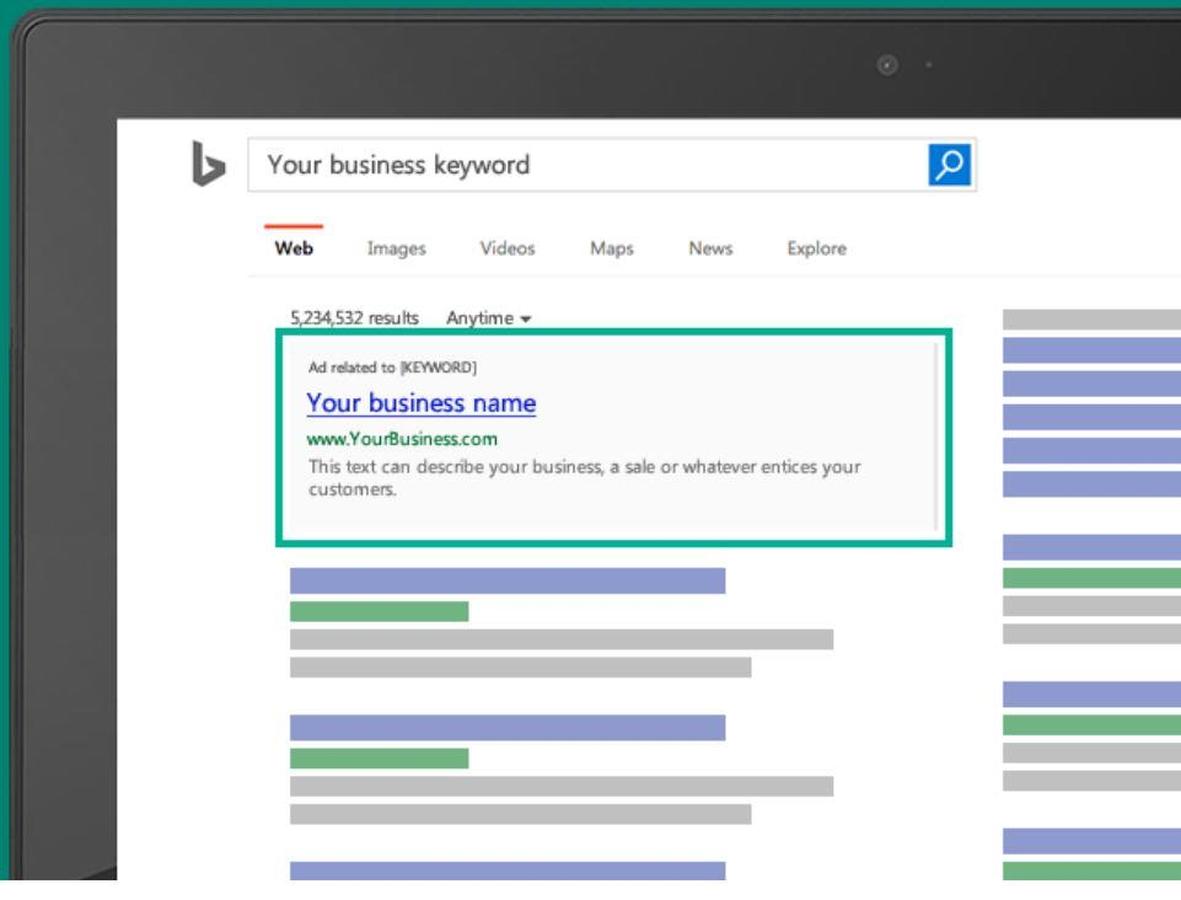
Honorable Mentions
Outside of these networks, there are hundreds of newer, more niche ad networks out there. Unfortunately, the size of these networks keeps us from finding the necessary CPC information we need. Some of the most notable niche ad networks are Snapchat, Pinterest, Reddit, and Tik Tok.
Although we couldn’t gather enough info about their average CPCs, we did gather other relevant KPIs (Key Performance Indicators) like CPMs (cost per 1,000 impressions) that show some data on the spend and results you can expect to see.
Snapchat
The average CPM (cost per 1,000 impressions) for Snapchat ads was $2.95 in 2018. This means that it only costs around $3 to advertise your product or service to 1,000 people on Snapchat.
Compared to the $4.20 average CPM for Instagram and the $5.12 average CPM for Facebook, Snapchat ads are a steal. How they convert could be a whole different conversation entirely.
The average CPM for Pinterest is $1.50, meaning that it only costs $1.50 to reach 1,000 people on Pinterest. This pricing is very attractive to the higher rates that Instagram, Facebook, and even Snapchat provide.
On the other hand, Pinterest only allows for 3 ad objectives: awareness, engagement, and traffic. They don’t provide a conversion objective for installs, leads, etc. like Facebook and Instagram. When looking for conversions, it may be worth it to pay higher CPMs on these other platforms for a larger return on your investment.
Reddit ads used to work on a flat rate CPM of $0.75. They have since changed that model to follow many of the other online advertisers by using an auctioning system where the minimum CPM bid is $0.20 and goes up from there.
Reddit advertising can be good for brand awareness by driving traffic and engagement, but in terms of translating into ROI, there are better platforms out there like Google, Facebook, and LinkedIn.
Tik Tok
Tik Tok is one of the newest social media platforms out there and also one of the newest online advertising platforms. It’s because of this that Tik Tok CPMs start at $10 and require advertisers to spend a minimum of $500 per campaign.
At this point in time, a $10 CPM is just not worth the potential results it could produce.